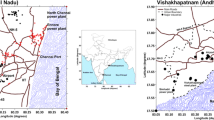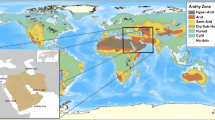Abstract
The World Health Organization (WHO) listed the air pollution in Ulaanbaatar (Mongolia) among the top 5 cities with the worst air quality in the world. Air quality in the winter season reaches highs of 750 μg/m3 for daily average fine particulates (PM) due to increased coal combustion and lower mixing heights (<200 m), coupled with the city’s geography surrounded by mountains, which further restricts the vertical and horizontal dispersion of the pollutants. The annual average concentrations in 2010–2011 ranged 136 ± 114 μg/m3 (the WHO guideline for fine PM is 10 μg/m3). The single largest source of particulate pollution in Ulaanbaatar is coal and biomass combustion in households and heat-only boilers, followed by power plants. In this paper, we present sector-specific emissions for 2010 accounting for 62,000 tons of fine PM, 55,000 tons of sulfur dioxide, and 89,000 tons of nitrogen oxide emissions. The inventory is spatially disaggregated at 0.01° resolution on a GIS platform for use in a chemical transport model (ATMoS). The modeled concentrations for the urban area ranged 153 ± 70 μg/m3, when overlaid on gridded population, resulted in estimated 1,000–1,500 premature deaths per year due to outdoor air pollution. This study also highlights the linkages between indoor and outdoor air pollution. In these harsh temperate conditions, with 50 % of the emissions originating from Ger households, they are as big a health risk for indoor air quality as they are for outdoor air quality. Any intervention improving combustion efficiency or providing clean fuel for these stoves will have a combined benefit for indoor air quality, outdoor air quality, and climate policy. The analysis shows that aggressive pollution control measures are imperative to protect the population in Ulaanbaatar from excess exposure levels, and implementation of control measures like the introduction of heat efficient stoves, clean coal for heating boilers, and urban transport planning will result in significant health benefits, which surpass any costs of institutional, technical, and economic interventions.








Similar content being viewed by others
References
Allen R, Gombojav E, Barkhasragchaa B, Byambaa T, Lkhasuren O, Amram O, Takaro T, Janes C (2013) An assessment of air pollution and its attributable mortality in Ulaanbaatar, Mongolia. Air Qual Atmos Health 6:137–150
Atkinson RW, Cohen A, Mehta S, Anderson HR (2011) Systematic review and meta-analysis of epidemiological time-series studies on outdoor air pollution and health in Asia. Air Qual Atmos Health 5:383–391
Bell ML, Davis DL, Gouveia N, Borja-Aburto VH, Cifuentes LA (2006) The avoidable health effects of air pollution in three Latin American cities: Santiago, São Paulo, and Mexico City. Environ Res 100:431–440
Burmaa B, Dorogova V, Enkhtsétség S, Erdénéchimég E, Enkhzhargal A (2002) Impact of lead-induced environmental pollution on children’s health in Mongolia. Gig Sanit 3:21–23
CAI-Asia (2008) Clean brick making technology—success of VSBK in Kathmandu. Clean air initiative for Asia cities, Manila, Philippines
Calori G, Carmichael GR (1999) An urban trajectory model for sulfur in Asian megacities: model concepts and preliminary application. Atmos Environ 33:3109–3117
Colbeck I, Nasir Z, Ali Z (2009) The state of ambient air quality in Pakistan—a review. Environ Sci Pollut Res 17:49–63
Cropper ML, Limonov A, Malik K, Singh A (2011) Estimating the impact of restructuring on electricity generation efficiency: the case of the Indian thermal power sector. National Bureau of Economic Research Working Paper Series No. 17383
Davy P, Gunchin G, Markwitz A et al (2011) Air particulate matter pollution in Ulaanbaatar, Mongolia: determination of composition, source contributions and source locations. Atmosp Pollut Res 2:126–137
Dorogova V, Burmaa B, Enkhtsetseg B et al (2008) Environmental lead pollution in Ulan-Bator and children’s health. Gig Sanit 4:8–9
ESMAP (2005) Impact of improved stoves on indoor air quality in Ulaanbaatar, Mongolia. Report 313/05, ESMAP Publication Series. The World Bank, Washington, DC
GAINS (2010) Greenhouse gas and air pollution interactions and synergies—South Asia program. International Institute of Applied Systems Analysis, Laxenburg, Austria
GRUMP (2010) Gridded Population of the World and Global Rural and Urban Mapping Project. Center for International Earth Science Information Network (CIESIN) of the Earth Institute, Columbia University, New York, NY
Gunchin G, Sereeter L, Dagva S et al (2012) Air particulate matter pollution in Ulaanbaatar city, Mongolia. Int J PIXE 22:165–171
Guttikunda S, Begum B, Wadud Z (2013) Particulate pollution from brick kiln clusters in the Greater Dhaka region, Bangladesh. Air Qual Atmos Health. doi:10.1007/s11869-012-0187-2
Guttikunda S, Gurjar B (2012) Role of meteorology in seasonality of air pollution in megacity Delhi, India. Environ Monit Assess 184:3199–3211
Guttikunda SK (2007) Urban air pollution analysis for Ulaanbaatar, Mongolia. Consultation report. The World Bank, Washington, DC
Guttikunda SK, Calori G (2013) A GIS based emissions inventory at 1 km × 1 km spatial resolution for air pollution analysis in Delhi, India. Atmos Environ 67:101–111
Guttikunda SK, Jawahar P (2012) Application of SIM-air modeling tools to assess air quality in Indian cities. Atmos Environ 62:551–561
HEI (2004) Health effects of outdoor air pollution in developing countries of Asia: a literature review. Special Report 15. Health Effects Institute, Boston, MA
HEI (2010) Outdoor air pollution and health in the developing countries of Asia: a comprehensive review. Special Report 18. Health Effects Institute, Boston, MA
Johnson TM, Guttikunda SK, Wells G et al (2011) Tools for improving air quality management. A review of top-down source apportiontment techniques and their application in developing countries. ESMAP Publication Series. The World Bank, Washington, DC
Kan H, Chen B, Chen C, Fu Q, Chen M (2004) An evaluation of public health impact of ambient air pollution under various energy scenarios in Shanghai, China. Atmos Environ 38:95–102
Lodoysamba S, Pemberton-Pigott C (2011) Mitigation of Ulaanbaatar city’s air pollution—from source apportionment to ultra-low emission lignite burning stoves. Proceedings of International conference Towards Sustainable Energy, Solutions for the Developing World, Domestic Use of Energy, April 12–13, 2011, Cape Peninsula University of Technology, Cape Town, South Africa
Luvsan M-E, Shie R-H, Purevdorj T et al (2012) The influence of emission sources and meteorological conditions on SO2 pollution in Mongolia. Atmos Environ 61:542–549
Mamtimin B, Meixner FX (2011) Air pollution and meteorological processes in the growing dryland city of Urumqi (Xinjiang, China). Sci Total Environ 409:1277–1290
Masoli M, Fabian D, Holt S, Beasley R, Global Initiative for Asthma (GINA) Program (2004) The global burden of asthma: executive summary of the GINA Dissemination Committee Report. Allergy 59:469–478
NCEP (2012) National Centers for Environmental Prediction. National Oceanic and Atmospheric Administration, Maryland, USA
NSO (2012) National Statistics Office of Mongolia. The Government of Mongolia, Ulaanbaatar, Mongolia
Ostro (2004) Outdoor air pollution: assessing the environmental burden of disease at national and local levels. Environmental Burden of Disease Series No. 5. World Health Organization, Geneva, Switzerland
Schipper L, Marie-Lilliu C, Gorham R (2000) Flexing the link between transport and greenhouse gas emissions: a path for the World Bank. International Energy Agency, Paris, France
Shinee E, Gombojav E, Nishimura A, Hamajima N, Ito K (2008) Healthcare waste management in the capital city of Mongolia. Waste Manage 28:435–441
Timilsina GR, Shrestha A (2009) Transport sector CO2 emissions growth in Asia: underlying factors and policy options. Energy Pol 37:4523–4539
Tung HD, Tong HY, Hung WT, Anh NTN (2011) Development of emission factors and emission inventories for motorcycles and light duty vehicles in the urban region in Vietnam. Sci Total Environ 409:2761–2767
USEPA (2006) Clearinghouse for inventories & emissions factors—AP 42 (5th edn). United States Environmental Protection Agency, Washington, DC
USGS (2012) Global land cover. USGS Land Cover Institute, Washington, DC
Wang H, Dwyer-Lindgren L, Lofgren KT et al (2012) Age-specific and sex-specific mortality in 187 countries, 1970–2010: a systematic analysis for the Global Burden of Disease Study 2010. Lancet 380:2071–2094
WHO (2004) Global burden of disease—methodology for estimating health risks. World Health Organization, Geneva, Switzerland
WHO (2011) Outdoor air pollution in the world cities. World Health Organization, Geneva, Switzerland
Wong C-M, Vichit-Vadakan N, Kan H, Qian Z (2008) Public Health and Air Pollution in Asia (PAPA): a multicity study of short-term effects of air pollution on mortality. Environ Health Perspect 116:1195–1202
World Bank (2004) Environmental challenges of urban development in Mongolia, East Asia Environment Monitor Series. The World Bank, Washington, DC
World Bank (2007) Rethinking the delivery of infrastrucure services in Mongolia. The World Bank, Washington, DC
World Bank (2010) Vertical shaft brick kiln—design manual. ESMAP Publication Series. The World Bank, Washington, DC
World Bank (2011) Air quality analysis of Ulaanbaatar improving air quality to reduce health impacts. The World Bank, Washington, DC
Yan F, Winijkul E, Jung S, Bond TC, Streets DG (2011) Global emission projections of particulate matter (PM): I. Exhaust emissions from on-road vehicles. Atmos Environ 45:4830–4844
Yim SHL, Barrett SRH (2012) Public health impacts of combustion emissions in the United Kingdom. Environ Sci Technol 46:4291–4296
Zhao Y, Wang S, Nielsen CP, Li X, Hao J (2010) Establishment of a database of emission factors for atmospheric pollutants from Chinese coal-fired power plants. Atmos Environ 44:1515–1523
Acknowledgments
We would like to acknowledge Ms. Oyuntsetseg Dugarsuren for her efforts in organizing meetings in Ulaanbaatar with various departments to facilitate data collection and Mr. Shagjjamba and Ms. Gerelmaa from the Nuclear Research Center of National University of Mongolia for their continuous support in the source apportionment studies.
Author information
Authors and Affiliations
Corresponding author
Additional information
Highlights
Fuel consumption and sector contributions to atmospheric emissions Seasonal variation in particulate pollution via dispersion modeling Winter pollution highs due to low inversion and high cookstove emissions Review of air pollution control initiatives in Ulaanbaatar
Rights and permissions
About this article
Cite this article
Guttikunda, S.K., Lodoysamba, S., Bulgansaikhan, B. et al. Particulate pollution in Ulaanbaatar, Mongolia. Air Qual Atmos Health 6, 589–601 (2013). https://doi.org/10.1007/s11869-013-0198-7
Received:
Accepted:
Published:
Issue Date:
DOI: https://doi.org/10.1007/s11869-013-0198-7




